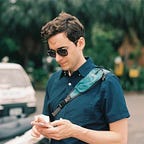Dupont St galleries, Toronto, April 29, 2017
Seven of the dozen galleries along Dupont St have exhibitions ending today. I tend to visit gallery exhibitions on the closing day rather than the opening night. The sun is out, and the air is crisp — just warm enough for my hands not to get cold while biking.
I ride to Barbary Edwards for Sorel Etrog, whose sculptures are recognizable by the motifs of links, screws, bolts, and hinges. Behind glass-panel doors in an unlit room among stacked parcels is Etrog’s Gemini (1976), the largest work in the exhibition. The gallery assistant explains that they had extended the exhibition, but had already received shipments for the next one.
I look through the glass panes of the double doors. The assistant offers to open the room so I can look closer. Gemini’s surface is rough, whereas that of the smaller sculptures is smooth. I think: large; rough; worn, as by time; like a monument. I appreciate this concordance between size and texture.
In describing Gemini, I want to say a ‘box’ resting on a ‘stand.’ I think about the semiotics of ‘box’: of holding or being able to hold, of being openable, of a space within. But the sculpture doesn’t open. Both sides of the hinge are cast and immovable. Is it a box, even as representation?
I ask the assistant about the significance of the hinges and screws. She describes their metaphors and associations, and opens a book for me to a page about the hinges.
I describe that hinges are manufactured by industry, ready-made, undifferentiated, interchangeable; there are no artisanal or unique hinges. But the figures’ heads, joints, eyes, mouths, ears, noses—people’s identifying and sensory parts — are links, screws, bolts, and hinges. What does that say?
I ask about this reading. It’s not one she’s familiar with. We chat about the selection of the works for the show.
Matter is a new gallery exclusively exhibiting international artists. Its first show has a couple works from each of six artists, for which the gallery will have solo exhibitions. It’s the last day.
I’m alone. The gallerist, Zack Pospieszynski, introduces me to the show and the artists.
I look at Siwa Mgoboza’s Who Let the Beings Out? I and IV for a while. Zack notices and plays an interview with Mgoboza for me.
In another photo, the model (or artist) stands in what looks like a tourist shop, juxtaposing real contemporary art with fake traditional art. I ask Zack about this, starting a great chat about Mgoboza and Aydin Büyüktas.
Büyüktas uses a drone and careful image stitching to produce his Flatland series. I describe the tension between putting myself in the scene and seeing the world curve up before me, and putting myself behind the camera and rising in an arc over the scene. (The tension between these two trajectories is strongest when alternately looking at the top and the bottom of the photo.)
Zack describes details I hadn’t noticed in New Mosque.
I notice the book Rebel, Jester, Mystic, Poet: Contemporary Persians by the curator of the exhibition of the same name, Fereshteh Daftari, which I saw at the Aga Khan Museum.
We talk about that exhibition. It’s interesting to hear his experiences of and responses to the works. We both love Parastou Forouhar’s Friday.
At Cooper Cole, I see Sandy Plotnikoff’s exhibition. It looks like it’s bark treated to look like scrap metal, but I can’t tell if it’s scrap metal treated and shaped to look like bark. (It’s bark.)
In the rest of the gallery, Elias Hansen’s work has the vibe of a post-apocalyptic maker culture — with its exposed duct tape and broken found objects — but I don’t understand the sporadic inclusion of pornographic playing cards. The gallery assistant suggests it’s to make the work more ‘edgy,’ but it feels edgy enough as-is.
I cross from Richard Rhodes to Angell for “The Readable City,” an all-female group exhibition.
I’m drawn to Jessica Thalmann’s prints and to thinking about the process: photograph a building (with its shadows), print, cut, fold, stack, photograph (with new shadows), print, frame.
I can’t naturally perceive which shadows exist in which scene: outside the building or inside the studio. It takes thought.
A 3D structure projected onto a 2D camera sensor, printed and folded into a 3D surface, then again made two-dimensional.
From durable and permanent to fragile and temporary.
Another print has different colors on different sides of the folds. I wonder whether the folding of an uncolored print decided the colors of the final print, or whether the coloring of a digital image decided the folds of the printed image.
I chat with the curator, Bill Clarke. He had been describing the works and ideas to a pair of collectors, so it’s a switch in the mode of conversation.
I ask about Malka Greene’s Synthetic. It looks at first like a 3D rendering, but it’s produced by a digital camera’s imperfect image stitching of an iconic building’s surface. I ask about Simone Rochon’s collages.
After Christie, I visit Katzman. The gallery displays Zeke Moores’ casts of aluminum and bronze that reproduce the grain and detail of wood and cardboard. I watch writing a gesture, in which Yvonne Singer repeatedly scratches with a fountain pen:
I will know you by your gesture
By your gesture will I know you
Will I know you by your gesture
I ask whether the video runs faster in reverse than forward. Marianne says no instantly, but Dario says so enthusiastically. He relates how other visitors felt anxiety as the words were erased with a sense of urgency in reverse; I share how the writing felt deliberate going forward. He shows me pages of writing produced during other recordings, each of which has an error; the artist repeated the recording until a page was error-free.
